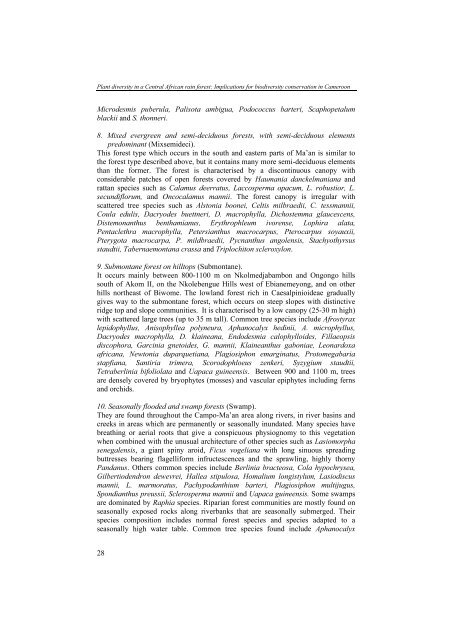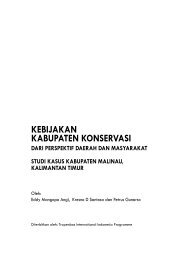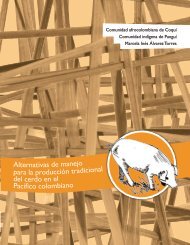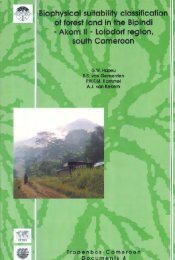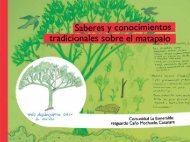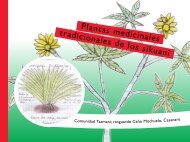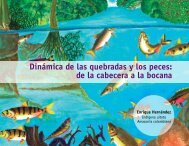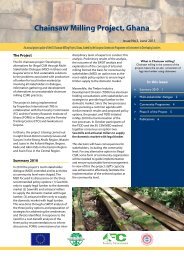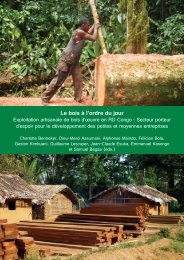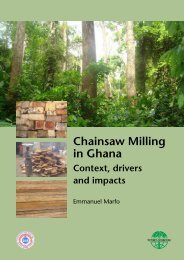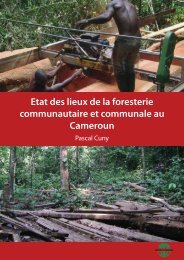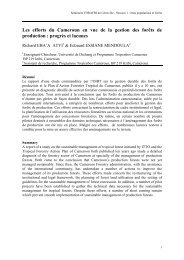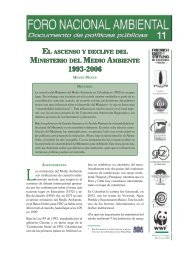Download the publication - Tropenbos International
Download the publication - Tropenbos International
Download the publication - Tropenbos International
Create successful ePaper yourself
Turn your PDF publications into a flip-book with our unique Google optimized e-Paper software.
Plant diversity in a Central African rain forest: Implications for biodiversity conservation in Cameroon<br />
Microdesmis puberula, Palisota ambigua, Podococcus barteri, Scaphopetalum<br />
blackii and S. thonneri.<br />
8. Mixed evergreen and semi-deciduous forests, with semi-deciduous elements<br />
predominant (Mixsemideci).<br />
This forest type which occurs in <strong>the</strong> south and eastern parts of Ma’an is similar to<br />
<strong>the</strong> forest type described above, but it contains many more semi-deciduous elements<br />
than <strong>the</strong> former. The forest is characterised by a discontinuous canopy with<br />
considerable patches of open forests covered by Haumania danckelmaniana and<br />
rattan species such as Calamus deerratus, Laccosperma opacum, L. robustior, L.<br />
secundiflorum, and Oncocalamus mannii. The forest canopy is irregular with<br />
scattered tree species such as Alstonia boonei, Celtis milbraedii, C. tessmannii,<br />
Coula edulis, Dacryodes buettneri, D. macrophylla, Dichostemma glaucescens,<br />
Distemonanthus benthamianus, Erythrophleum ivorense, Lophira alata,<br />
Pentaclethra macrophylla, Petersianthus macrocarpus, Pterocarpus soyauxii,<br />
Pterygota macrocarpa, P. mildbraedii, Pycnanthus angolensis, Stachyothyrsus<br />
staudtii, Tabernaemontana crassa and Triplochiton scleroxylon.<br />
9. Submontane forest on hilltops (Submontane).<br />
It occurs mainly between 800-1100 m on Nkolmedjabambon and Ongongo hills<br />
south of Akom II, on <strong>the</strong> Nkolebengue Hills west of Ebianemeyong, and on o<strong>the</strong>r<br />
hills nor<strong>the</strong>ast of Biwome. The lowland forest rich in Caesalpinioideae gradually<br />
gives way to <strong>the</strong> submontane forest, which occurs on steep slopes with distinctive<br />
ridge top and slope communities. It is characterised by a low canopy (25-30 m high)<br />
with scattered large trees (up to 35 m tall). Common tree species include Afrostyrax<br />
lepidophyllus, Anisophyllea polyneura, Aphanocalyx hedinii, A. microphyllus,<br />
Dacryodes macrophylla, D. klaineana, Endodesmia calophylloides, Fillaeopsis<br />
discophora, Garcinia gnetoides, G. mannii, Klaineanthus gaboniae, Leonardoxa<br />
africana, Newtonia duparquetiana, Plagiosiphon emarginatus, Protomegabaria<br />
stapfiana, Santiria trimera, Scorodophloeus zenkeri, Syzygium staudtii,<br />
Tetraberlinia bifoliolata and Uapaca guineensis. Between 900 and 1100 m, trees<br />
are densely covered by bryophytes (mosses) and vascular epiphytes including ferns<br />
and orchids.<br />
10. Seasonally flooded and swamp forests (Swamp).<br />
They are found throughout <strong>the</strong> Campo-Ma’an area along rivers, in river basins and<br />
creeks in areas which are permanently or seasonally inundated. Many species have<br />
breathing or aerial roots that give a conspicuous physiognomy to this vegetation<br />
when combined with <strong>the</strong> unusual architecture of o<strong>the</strong>r species such as Lasiomorpha<br />
senegalensis, a giant spiny aroid, Ficus vogeliana with long sinuous spreading<br />
buttresses bearing flagelliform infructescences and <strong>the</strong> sprawling, highly thorny<br />
Pandanus. O<strong>the</strong>rs common species include Berlinia bracteosa, Cola hypochrysea,<br />
Gilbertiodendron dewevrei, Hallea stipulosa, Homalium longistylum, Lasiodiscus<br />
mannii, L. marmoratus, Pachypodanthium barteri, Plagiosiphon multijugus,<br />
Spondianthus preussii, Sclerosperma mannii and Uapaca guineensis. Some swamps<br />
are dominated by Raphia species. Riparian forest communities are mostly found on<br />
seasonally exposed rocks along riverbanks that are seasonally submerged. Their<br />
species composition includes normal forest species and species adapted to a<br />
seasonally high water table. Common tree species found include Aphanocalyx<br />
28


